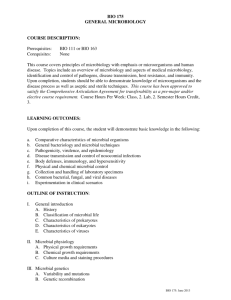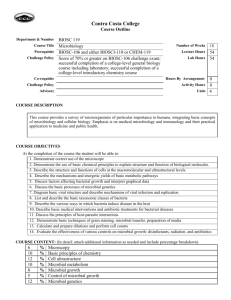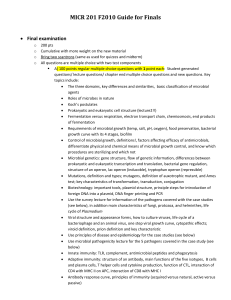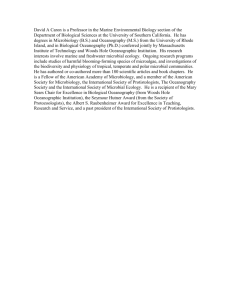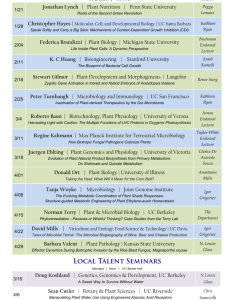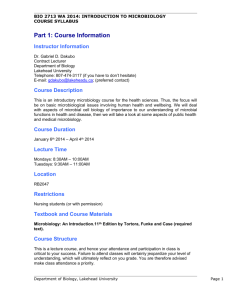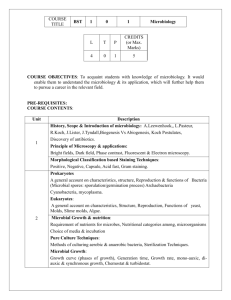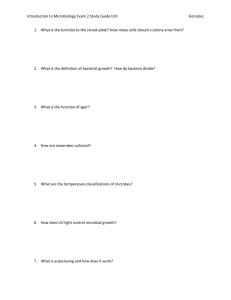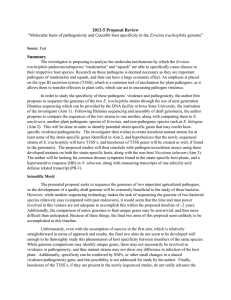Microbiology / Active Lecture Questions Chapter 15 / Microbial
advertisement
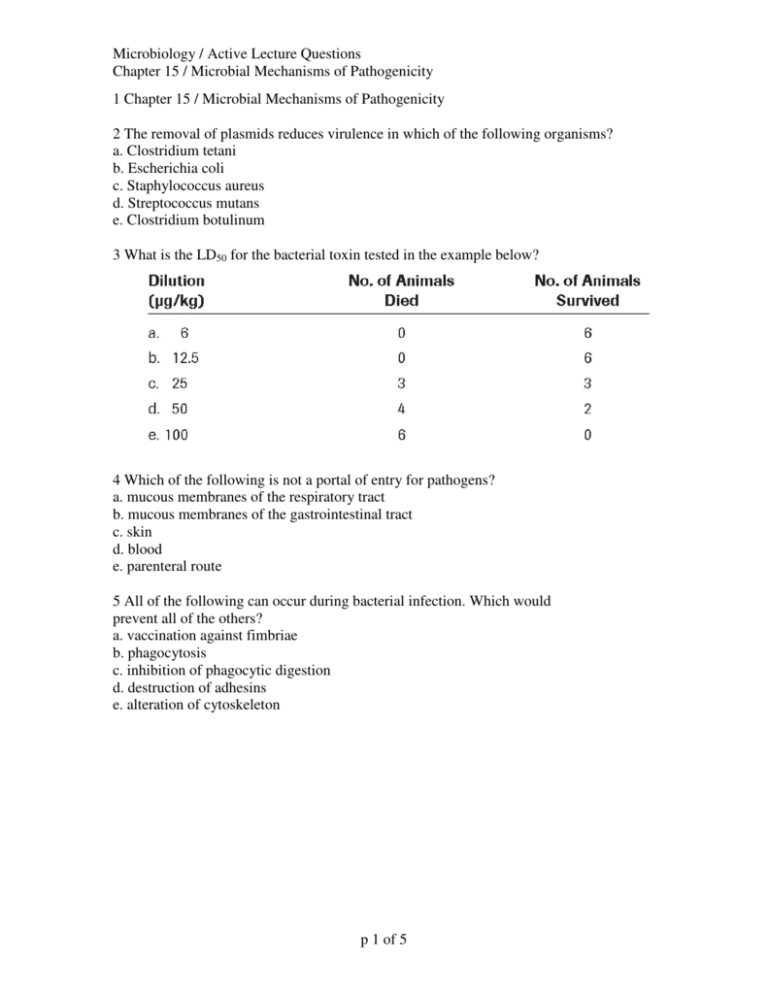
Microbiology / Active Lecture Questions Chapter 15 / Microbial Mechanisms of Pathogenicity 1 Chapter 15 / Microbial Mechanisms of Pathogenicity 2 The removal of plasmids reduces virulence in which of the following organisms? a. Clostridium tetani b. Escherichia coli c. Staphylococcus aureus d. Streptococcus mutans e. Clostridium botulinum 3 What is the LD50 for the bacterial toxin tested in the example below? 4 Which of the following is not a portal of entry for pathogens? a. mucous membranes of the respiratory tract b. mucous membranes of the gastrointestinal tract c. skin d. blood e. parenteral route 5 All of the following can occur during bacterial infection. Which would prevent all of the others? a. vaccination against fimbriae b. phagocytosis c. inhibition of phagocytic digestion d. destruction of adhesins e. alteration of cytoskeleton p 1 of 5 Microbiology / Active Lecture Questions Chapter 15 / Microbial Mechanisms of Pathogenicity 6 The ID50 for Campylobacter sp. is 500 cells; the ID50 for Cryptosporidium sp. is 100 cells. Which of the following statements is not true? a. Both microbes are pathogens. b. Both microbes produce infections in 50% of the inoculated hosts. c. Cryptosporidium is more virulent than Campylobacter. d. Campylobacter and Cryptosporidium are equally virulent; they cause infections in the same number of test animals. e. The severity of infections caused by Campylobacter and Cryptosporidium cannot be determined by the information provided. 7 An encapsulated bacterium can be virulent because the capsule a. resists phagocytosis. b. is an endotoxin. c. destroys host tissues. d. interferes with physiological processes. e. has no effect; because many pathogens do not have capsules, capsules do not contribute to virulence. 8 A drug that binds to mannose on human cells would prevent a. the entrance of Vibrio enterotoxin. b. the attachment of pathogenic E. coli. c. the action of botulinum toxin. d. streptococcal pneumonia. e. the action of diphtheria toxin. 9 The earliest smallpox vaccines were infected tissue rubbed into the skin of a healthy person. The recipient of such a vaccine usually developed a mild case of smallpox, recovered, and was immune thereafter. What is the most likely reason this vaccine did not kill more people? a. Skin is the wrong portal of entry for smallpox. b. The vaccine consisted of a mild form of the virus. c. Smallpox is normally transmitted by skin-to-skin contact. d. Smallpox is a virus. e. The virus mutated. 10 Which of the following does not represent the same mechanism for avoiding host defenses as the others? a. Rabies virus attaches to the receptor for the neurotransmitter acetylcholine. b. Salmonella attaches to the receptor for epidermal growth factor. c. Epstein-Barr (EB) virus binds to the host receptor for complement. d. Surface protein genes in Neisseria gonorrhoeae mutate frequently. e. none of the above p 2 of 5 Microbiology / Active Lecture Questions Chapter 15 / Microbial Mechanisms of Pathogenicity 11 Which of the following statements is true? a. The primary goal of a pathogen is to kill its host. b. Evolution selects for the most virulent pathogens. c. A successful pathogen doesn’t kill its host before it is transmitted. d. A successful pathogen never kills its host. 12 Which portal of entry is most often used by microorganisms? a. Parenteral route b. Mucous membranes of the respiratory route c. Mucous membranes of the conjunctiva d. Skin 13 One disease that can be transmitted by the parenteral route is a. Tetanus b. Trachoma c. Influenza d. Tuberculosis 14 When pathogens enter the skin, they usually a. Enter through the hair follicles and sweat ducts b. Penetrate intact skin c. Are injected into the skin d. Adhere to the skin and then penetrate the skin 15 To prevent the disease botulism, which is caused by ingesting an exotoxin, it is necessary to a. Avoid canned food b. Boil food prior to consumption c. Prevent fecal contamination of food d. Administer antibiotics to patients 16 Which organism produces an exotoxin? a. Proteus spp. b. Neisseria meningitidis c. Staphylococcus aureus d. Salmonella typhi 17 Clostridium tetani causes the disease tetanus because it produces a. An endotoxin b. An exotoxin c. A capsule d. An enzyme p 3 of 5 Microbiology / Active Lecture Questions Chapter 15 / Microbial Mechanisms of Pathogenicity 18 Which of the following allows viruses to gain access to target cells? a. Fimbriae b. Attachment sites c. Inclusion bodies d. Capsids 19 Which of the following refers to the visible effects of a viral infection? a. Lysogenic conversion b. Lysogenic effects c. Cytopathic effects d. Cytopathic conversion 20 Bacteriophages can contribute to bacterial virulence because they can a. Carry plasmids b. Produce toxins c. Give new gene sequences to the host bacteria d. Kill the bacteria causing release of endotoxins 21 Which of the following DOES NOT contribute to fungal disease? a. Cell walls b. Toxins c. Capsules d. Allergic response of the host 22 Which of these toxins is an alkaloid that can cause hallucinations resembling those produced by LSD? a. Aflatoxin b. Ergot c. Phalloidin d. Amanitin 23 What is the causative agent of elephantiasis? a. Entamoeba histolytica b. Candida albicans c. Cryptococcus neoformans d. Wuchereria bancrofti 24 Arthropods provide a portal of exit for microbes in a. Skin b. Blood c. Respiratory tract d. Genitourinary tract p 4 of 5 Microbiology / Active Lecture Questions Chapter 15 / Microbial Mechanisms of Pathogenicity 25 Pathogens that are discharged from the respiratory tract cause the following disease: a. Salmonella b. Whooping cough c. Poliomyelitis d. Rabies 26 The following disease can be transmitted by a biting insect: a. Shigellosis b. Mumps c. Tularemia d. Chickenpox p 5 of 5

